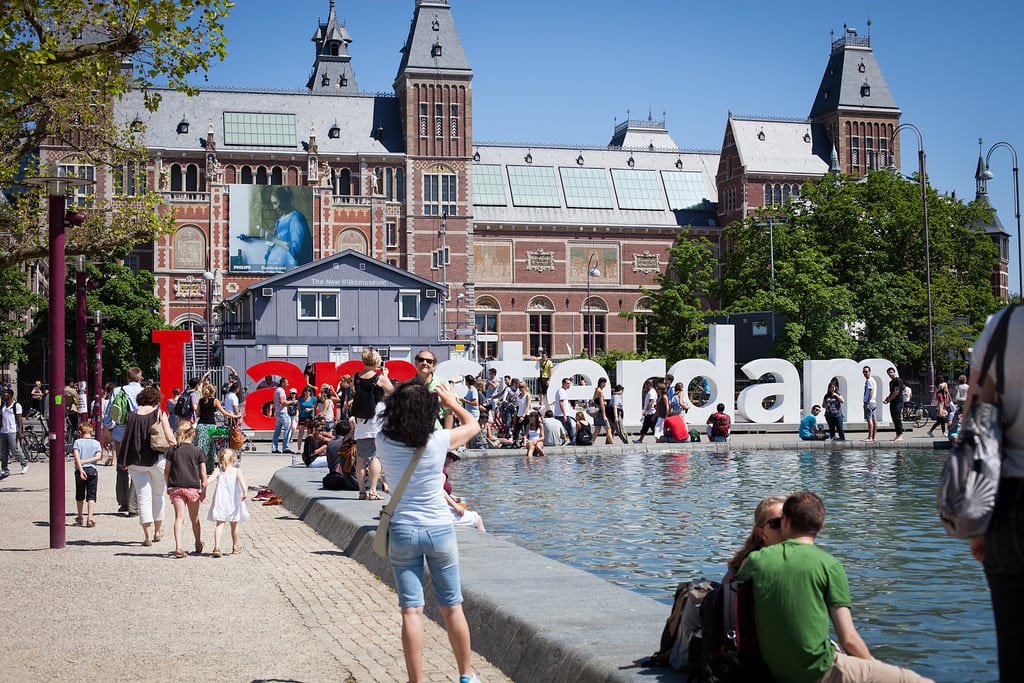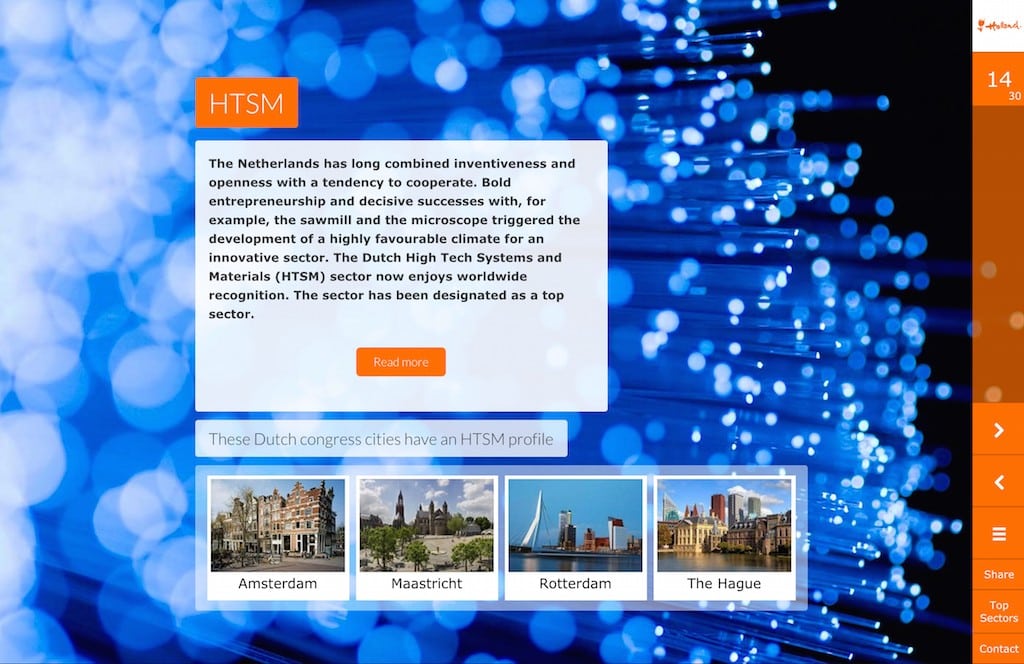Skift Take
This is the first time a convention bureau has launched an official website promoting a destination's intellectual software ahead of its infrastructure hardware.
The Netherlands Board of Tourism & Conventions (NBTC) is announcing publicly today a new meetings and conventions industry website that redefines how convention bureaus are engaging meeting planners.
Instead of the typical category lists of convention centers, hotels and other meeting venues, the new Conventions.Holland.com portal is organized around the nine most prolific industry sectors that the country specializes in for international congresses.
The website is not fully complete but Skift was granted access to announce the platform today.
The nine industry sectors are: agriculture, chemical, creative (media/design), energy, high-tech, logistics, justice and security, and water management. The landing pages for each provide an overview and vidoes of the specific industry, and link to landing pages for the specific destinations that specialize in those fields. From there, planners can then navigate to the convention bureaus and any number of destination partners.
There are two primary factors behind the decision to structure the website this way.
First, as we’ve previously defined and deciphered numerous times at Skift, the most innovative convention bureaus today are promoting their destination’s intellectual and business expertise as much as their meetings infrastructure. It’s a shift in emphasis from urban hardware to knowledge capital to attract convention planners in a competitive market where so many first-tier cities today all have modern meetings facilities.
The second factor behind the new website is the massive redevelopment of Amsterdam and its outlying regions, due to the booming population growth within the city limits. As explained in the recent Skift & MasterCard Future Cities project — Amsterdam: A Master Plan for A Smart City — Amsterdam is developing ways to connect its urban core with the rapidly expanding outlying districts to create the unified Amsterdam Metropolitan Area.
One of the purposes behind that is to facilitate easier connectivity between businesses and industry knowledge, while at the same time, incentivizing businesses to disperse more broadly among the metropolitan area. All of this is laid out in the Amsterdam City Council’s Structural Vision Amsterdam 2040 master plan launched in 2011.
Seeing the value of developing the Amsterdam Metro Area as a more aggregate whole, the NBTC and the nation’s primary convention bureaus want to expand on that concept and rebrand the entire country into a new NBTC initiative called “Holland City.”
If the majority of Dutch industry and citizens can be collectively positioned as basically a European megacity, then that elevates Holland’s stature among the meetings and convention industry because the country can now bring so much more to the table for any business event.
What makes this possible is Holland’s relatively diminutive size. The three major financial and industry centers — Amsterdam, Rotterdam and The Hague — coexist inside a 35-mile circle with Schiphol International Airport in the middle. High-speed trains from Schiphol run 20 minutes to Amsterdam and 30 minutes to Rotterdam, which makes Holland City a so-called “Aerotropolis,” where interconnected municipalities cluster around an international gateway epicenter to drive global trade.
The NBTC points out that the geographical footprint of those three cities combined fits easily within the urban boundaries of Los Angeles and Beijing.
“To really be as successful as we can, we need to think as big as we can because a whole lot of new opportunities arise when we look beyond the borders of the municipalities,” says Jos Vranken, managing director of the NBTC, and CEO of Holland Tourism. “We’ll never be a city as such, but mentally and conceptually we should really act and think as one city. Therefore, we can open up new opportunities for regional spread, new business propositions and products, and new destinations where everything is just another district away.”
Now, for example, when a meeting planner with a company or association involved in logistics and mobility is sourcing destinations, they’re not just looking at Rotterdam. They’re looking at Holland City and everything that comes with that.
“When it comes to meetings and conventions, we are in a global industry which is growing fast,” explains Vranken. “In order to be successful and sustainable as a destination, we need to offer the same level of expertise as the global capital cities. So we’re acting more like Singapore than as a country.”
The actual “Holland City” phrasing is not consumer-facing yet, but its precepts are now in motion with the new website. That’s why Conventions.Holland.com is groundbreaking. It’s designed to support the destination sourcing journey by promoting national industry expertise foremost, ahead of a siloed list of individual cities promoting their Hilton and Marriott convention center hotels.
That aligns with the future of marketing destinations for meetings and conventions, and it positions the country as one comprehensive “brainport” encompassing a much more holistic breadth of knowledge that planners can more easily access.
Infrastructure Development to Support Holland City
The aforementioned Structural Vision Amsterdam 2040 master plan includes a significant amount of new transportation infrastructure under development that further bolsters the viability of Holland City. The report reads: “At the moment a number of important links in the regional public transport system are lacking. Through to 2040, the necessary ‘network-wide leap’ must be achieved.”
That includes upgrading Holland’s existing high-speed train network. In the fast-growing Zuidas district between Amsterdam and Schiphol, where the Amsterdam RAI Convention Centre is located, the Station-Zuid rail hub is expanding significantly to improve linkages between Amsterdam and the rest of Holland.
“For planners, the Holland City plan makes a lot of sense because Holland has much more to offer than just Amsterdam, but we needed to figure out how do you make it viable for planners,” says Antonia Koedijk, U.S. director of business development for the NBTC. “You can get from Schiphol airport in Amsterdam to your hotel in Rotterdam in 45 minutes, so that’s something we need to emphasize more to international planners.”
Koedijk adds that cities such as Maastricht in the south are included in the evolution of Holland City because they bring important players to the country’s overall product lineup of industry sector expertise. Maastricht is a hub for chemical manufacturing, for example, and the city also joined the Holland Congress Alliance as a primary partner along with Amsterdam, Rotterdam, The Hague and some of their industry partners. Koedijk says that membership provides added connectivity to U.S. groups which typically have always gravitated to the capital.
“Our major partner in the U.S. was always Amsterdam, but now we have many more partnerships so we get out into the industry with a much broader offering,” Koedijk explains. She says Groningen in the eastern part of the Netherlands is also important because it has a major university and powerful agri-economic industry.
However, Maastricht and Groningen are both approximately 2.5 hours away by train so they’re going to be more challenging to integrate into the Holland City platform from the perspective of U.S. convention organizers. The NBTC will have better success including the more remote destinations in the country-wide package if it promotes the spirit of collaboration inherent in Dutch tradition. That’s why this project has a chance in Holland more so than somewhere like the United States.
A Legacy of Dutch Tradition
Here’s an analogy for Holland City in America. Imagine Fort Worth, Dallas and regional tourism bureaus like Irving circling their wagons around Dallas/Fort Worth International Airport and rebranding themselves “Texas City.” It’s almost impossible to imagine the Dallas and Fort Worth bureaus sharing sales leads and promoting each other’s partners. It could potentially work but you wouldn’t want to hold your breath waiting for it to happen.
Whereas, the mentality in Europe is to get groups interested in Europe or a specific European country first, and then compete for prospects after that. It’s why destinations like Barcelona and Vienna participate in sales calls together, and why individual German cities help sell each other.
In Holland, Vranken says the reason behind the progressive, creative and cooperative national psyche typically associated with the Dutch goes back to Holland’s relationship with water. He explains that much of Amsterdam is below sea level, spread across 60 miles of canals dating to the 17th century. Rotterdam is home to Europe’s busiest seaside port, first established in the 14th century.
Adapting to the rhythm of the sea and flow of canals taught the early Dutch the value of adapting to what can’t be controlled, and working collaboratively with the environment and local people to achieve a common goal.
“In order for the Netherlands to exist, by default, derives from being open-minded with an external outlook, and open to cooperation models that are necessary to live and work in a country that is so densely populated, and which consists of 20% of water,” says Vranken. “If we wouldn’t have managed the water, half of us would be underwater. So cooperation models, the way we cooperate, the way we are looking at challenges in a very pragmatic function is at the very root of our DNA. Cooperation is part of our essence of being that ultimately shows through in a campaign like Holland City.”
Have a confidential tip for Skift? Get in touch
Tags: ceo interviews, holland, the netherlands, tourism
Photo credit: The renovated exterior of the Dutch Rijksmuseum in Amsterdam. Christian Lendl / Flickr

